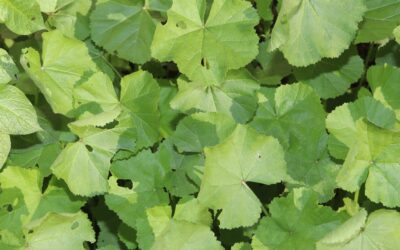Mallow weed is a common problem for commercial facility and property managers, quickly taking over landscapes if not properly controlled. These pesky weeds can be identified by their round, fuzzy leaves and small pink or white flowers. In this ultimate guide, we'll...
Recent Posts
The Landscaper’s Guide To Plant Growth Regulators
Landscapers often struggle with controlling plant sizes and health. Plant Growth Regulators (PGRs) are organic compounds that modify plant growth. This article will guide you in using PGRs to solve common landscaping challenges. Read on for a landscaper's guide to...
How Lawn Pest Control Enhances Overall Landscape Health
According to recent research by the University of Princeton, lawns account for over 40 million acres of American land today. Maintaining a lush, green space is more than just a matter of aesthetics; it's about creating a healthy, sustainable outdoor environment. One...
From discolored leaves to unexplained wilting, plants and trees in our gardens often show signs of stress that puzzle even the most diligent homeowners.
According to a 2022 survey, 40% of American gardeners faced plant health issues they couldn’t solve on their own.
When standard fertilizing and watering routines don’t yield the desired results, it’s time to consult the experts. Arborists and tree surgeons specialize in diagnosing and treating the unique problems that plague plant life.
Continue reading to explore how these professionals can help you resolve stubborn plant and tree challenges, ensuring your garden remains a thriving ecosystem
How an Arborist and Tree Surgeon Address Soil Problems
Trees rely on moist, porous, nutrient-rich soil inhabited by abundant living organisms for oxygen, water, and nutrients.
Good soil is so important for ensuring healthy plants that soil degradation poses a real threat to global food security. In nature, ongoing cycles of decay and rebirth take care of soil health, but this is difficult to emulate in real life.
Urban soils impacted by compaction and construction often fall short when it comes to supporting tree health. Signs that a tree is suffering from poor soil quality include a browning canopy, wilting leaves, and falling branches.
An arborist will analyze the soil surrounding an unhealthy tree and take steps to improve it so your tree can thrive again.
Pest Invasions
Healthy trees are a wonderful environment for birds and helpful insects, but they’re also attractive to less desirable bugs. Insects can quickly damage your trees, leaving them dilapidated, diseased, and bare.
An arborist can identify the problem quickly and take action against offending insects before they wreak more havoc. In many cases, your trees may need chemical treatment to eliminate the offending insects.
A qualified arborist will carry out the correct treatment without causing harm to your family, plants, or pets. They will set up an ongoing preventive program to protect your trees.
A tree surgeon can help remove any dead or infested branches, along with their resident population of bugs.
Identifying Tree Health Issues with an Arborist and Tree Surgeon
Fungi and bacteria also revel in the attractive environment created by trees. This can cause an array of tree diseases, such as:
Fusiform Rust
This is one of the most common causes of sick trees in Florida. It’s caused by a fungus that creates galls and blisters on the main stem of trees, killing the tree.
If they catch it early, an arborist can treat this disease by removing the infected bark. In severe cases, infected trees are a safety hazard due to stem breakage, and you’ll need to call in a tree surgeon to remove the diseased tree.
Laurel Wilt
Laurel wilt is a deadly fungal disease. It usually affects trees in the laurel family, like swamp bay, red bay, and avocado trees. The alien red bay ambrosia beetle commonly introduces the infection.
Signs that your tree has laurel wilt include green, wilted leaves in the canopy, dark streaks under the bark, and tiny holes with sawdust tubes on the limbs and trunk.
There’s no treatment for laurel wilt, but you need to act fast to stop it spreading. A tree surgeon should remove the tree, chip it, or burn it.
Brown Spot Needle Blight
Another fungal disease, this ailment infects young pine seedlings and kills them before they reach maturity. Symptoms of brown spot needle blight in more mature trees include spots on the needles and dead needle tips.
An arborist can treat this disease using a specific fungicide.
Ganoderma
Ganoderma results from a pathogenic infection in trees and shrubs. It usually enters the plant through torn or damaged roots, attacking the root system and killing the tree.
Symptoms of Ganoderma include yellow, wilting leaves, a lackluster appearance, and conk-formation on the bottom of the trunk.
There is no treatment for this tree disease, and the best way to avoid it is by taking good care of your trees’ roots.
Overgrown Roots and Branches
Root maintenance is an important part of tree care. As your trees get bigger, their root systems grow to accommodate their feeding needs.
Sometimes, tree roots grow out of control, threatening to wreak havoc on nearby construction. Large roots can puncture your septic tank, damage your home’s foundation, and lift your driveway.
A trained arborist knows how best to prevent this damage. They can trim roots without damaging the tree or your surrounding structures.
Overgrown branches may extend too far into your walkways or your yard, blocking access and casting shade where you don’t want it. Trimming trees is an art, especially if you want to preserve the appearance and health of your tree.
A skilled arborist can trim overgrown or untidy branches safely without harming the tree or detracting from its appearance. If you like the idea of a topiary garden, an arborist can help make this wish come true.
Wind and Weather Damage
As part of a layered landscape or when used as a windbreak, trees often face the brunt of inclement weather. Severe storms and high winds can damage trees, whipping off their leaves, snapping branches, and even breaking trunks.
Damaged trees are dangerous and unsightly; they could fall at any time. A leaning tree poses a serious risk to nearby buildings and people.
A tree surgeon or arborist should assess your trees after extreme weather incidents so they can repair any damages or determine another safe course of action. They can make qualified decisions about removing a leaning tree or restoring it to its former glory.
Where to Find an Arborist and a Tree Surgeon
Hiring an established landscaping company with an arborist and tree surgeon on their payroll takes the guesswork out of caring for your plants.
Sunrise Landscape’s experts check up on your trees during every visit and are ready to assist with any emergency tree problems. We use proactive measures to keep your trees healthy and looking their best.
Get in touch for more information about creating the perfect garden for your home.
Contact Us
"*" indicates required fields
Recent Posts
Mallow Weed Control: The Ultimate Guide
Mallow weed is a common problem for commercial facility and property managers, quickly taking over landscapes if not properly controlled. These pesky weeds can be identified by their round, fuzzy leaves and small pink or white flowers. In this ultimate guide, we'll...
The Landscaper’s Guide To Plant Growth Regulators
Landscapers often struggle with controlling plant sizes and health. Plant Growth Regulators (PGRs) are organic compounds that modify plant growth. This article will guide you in using PGRs to solve common landscaping challenges. Read on for a landscaper's guide to...



